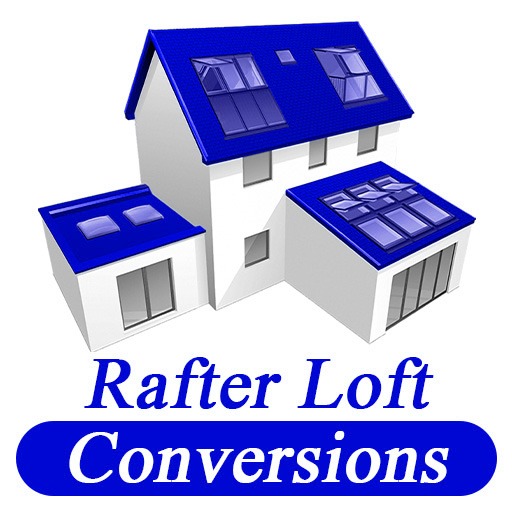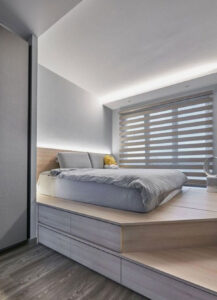LOFT CONVERSIONS IN BOWNESS
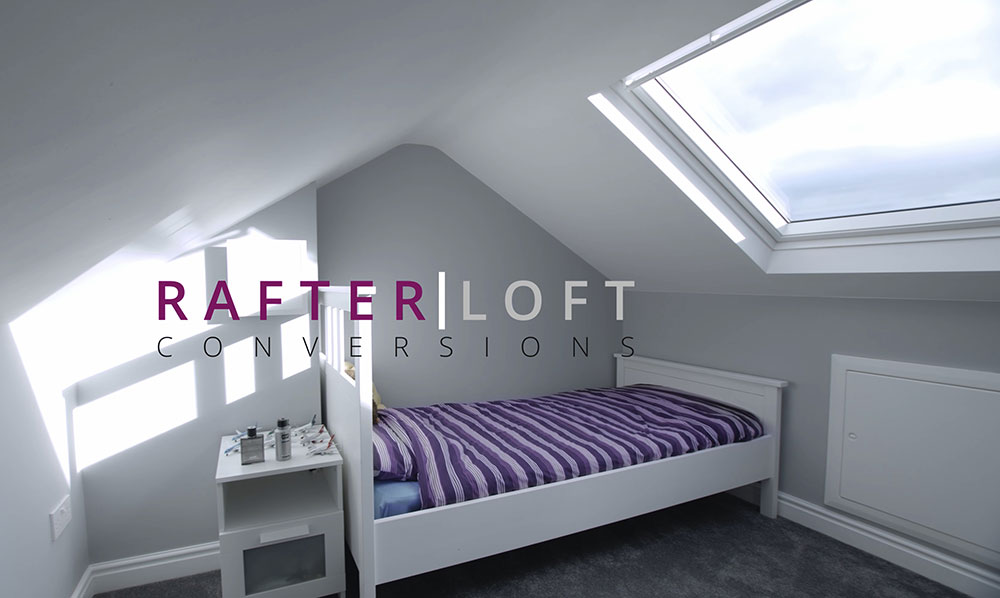
Rafter Loft Conversions undertake all types of loft conversions throughout the Lake District including Bowness On Windermere, from Velux conversions to dormer conversions, with years of experience in the design & construction of loft conversions, our design team will advise you on which solution would be ideal for your home whilst trying to add as much value as possible.
Rafter Loft Conversions are specialists in both traditional and truss rafter loft conversions, so look no further If you’re looking for a quality loft conversion and a competitive price. A loft conversion may be the perfect solution to achieving the extra room you require without having to move.
With our personal approach and considerate working manner, combined with our extensive knowledge in this specialised field is something we are extremely proud of. To see what Rafter Lofts Conversions can do for you, simply complete and submit our contact form below and we will contact you at your shortly to make a mutual appointment. Or call: 0800 086 2968
For advice on any type of loft conversion or to book a free no-obligation loft conversion
- Fill Form Below
-
-
HELP DESK 24H/7
We will make a mutual appointment to undertake a survey of your home and you will be able to ask any questions regarding your loft conversion, we try and have your loft proposal sent including your loft plan/layout within a few days of the visit, this also give you the opportunity to view your plans, (Rafter-Loft’s believe it is necessary for our clients to understand the actual finished profile of your loft conversion before you proceed) if there are any amendments you desire, we will amend your plans prior of undertaking a structural survey. Rafter Loft Conversions (Manchester) will then undertake a structural survey and submit them to the relevant Building Control bodies. To speak to our friendly team Call: 0800 161 3815.
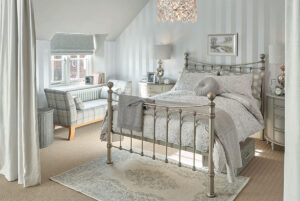 Planning permission makes sure no build would be out of character to the street scene or any overdevelopment is made to a site, if any part of the loft development or alteration is undertaken on the front elevation (facing a public highway) i.e. flat roof dormer, cottage dormer, eyebrow, etc, this must go through for planning permission first.
If for any reason your loft conversion in BOWNESS does not meet building regulations standards as an approved build, the local authority can insist to have the work’s condemned and put back to the original state before any commencement of works, if you risk and choose not to proceed through the appropriate channels you will end up paying for it dearly in the long run.
It is not only the builder’s responsibility to follow the regulations but also the home owner’s.
Any new structural members or alterations to an existing roof must be undertaken by a structural engineer as this ensures both the structural sufficiency and stability of the structure, formal calculations will be requested by building control in support of an application for approval.
Any electric work undertaken for your loft conversion in BOWNESS must meet and conform to the IEE Wiring Regulations 17th Edition, BS1761 2008. The person undertaking the electrics should be registered under a competent person scheme, for example, NiC, Napit, etc, an approved electrician will connect the new circuit/s and undertake a series of tests, for example, RCD trip time, earth bonding, resistance test, and continuity test, once completed an electrical certificate will be issued, a copy of your loft conversion with a copy of the electrical certificate should be put with the deeds to your home as It is important for, if and when you come to sell your home if you cannot produce the correct paperwork for the approval of your loft conversion, not only can it decrease the value of the property, it may put off potential buyers.
Every loft conversion with no exception is subject to building regulations, having a loft conversion is a major structural job, for example introducing new calculated floor joists, these must not exceed past the maximum span so they have the integrity of support, you have to take in account the insulation, electrics, and plumbing. Building regulations are in place not only to make sure the new structure is structurally sound and conforms to regulation but for the safety of the workers and property owners.
All building work, plumbing, and electrical works are checked by the building inspector to prove that it is too standard, but also it is important that you follow the building regulations have been followed throughout the build for other reasons as well. Insulation is again a major part of building control, it is good to practice to take photos throughout the build, so if let’s say you need to put the floor down in a bathroom area to set out for your ceramics, etc, if pipes or cables are now running through your floor joists taking a picture to show that all holes cut are acceptable with all cables and pipes clipped and a minimum of 50mm down from the top of the new joists a photo should be sufficient. The appointed building inspector is there for one reason only, to make sure that all works that have been carried out for your loft conversion are safe and that the materials have got the appropriate structural integrity.
If and when you ever come to sell your home and you cannot produce the correct paperwork or the approval for your loft conversion not only can it decrease the value of the property, it will probably put off potential purchases from buying your house.
Your loft conversion can look good from the outside and inside, but it if doesn’t meet building regulations as an approved extension in the eyes of a surveyor the work will be condemned, by not going through the proper channels you will end up paying dearly for it in the long run. It is not only the builder’s responsibility to follow the regulations but the home owner’s as well, heavy fines can be imposed on both parties, not only that, they will also require your loft conversion to be pulled down and put back to the original condition.
DIY, it is important to follow the building regulations, not only for yourself but also to ensure the safety of others around you. You should not just rely on your tradespeople to comply with the building regulations but also refer to them when you undertake any DIY work.
Planning permission makes sure no build would be out of character to the street scene or any overdevelopment is made to a site, if any part of the loft development or alteration is undertaken on the front elevation (facing a public highway) i.e. flat roof dormer, cottage dormer, eyebrow, etc, this must go through for planning permission first.
If for any reason your loft conversion in BOWNESS does not meet building regulations standards as an approved build, the local authority can insist to have the work’s condemned and put back to the original state before any commencement of works, if you risk and choose not to proceed through the appropriate channels you will end up paying for it dearly in the long run.
It is not only the builder’s responsibility to follow the regulations but also the home owner’s.
Any new structural members or alterations to an existing roof must be undertaken by a structural engineer as this ensures both the structural sufficiency and stability of the structure, formal calculations will be requested by building control in support of an application for approval.
Any electric work undertaken for your loft conversion in BOWNESS must meet and conform to the IEE Wiring Regulations 17th Edition, BS1761 2008. The person undertaking the electrics should be registered under a competent person scheme, for example, NiC, Napit, etc, an approved electrician will connect the new circuit/s and undertake a series of tests, for example, RCD trip time, earth bonding, resistance test, and continuity test, once completed an electrical certificate will be issued, a copy of your loft conversion with a copy of the electrical certificate should be put with the deeds to your home as It is important for, if and when you come to sell your home if you cannot produce the correct paperwork for the approval of your loft conversion, not only can it decrease the value of the property, it may put off potential buyers.
Every loft conversion with no exception is subject to building regulations, having a loft conversion is a major structural job, for example introducing new calculated floor joists, these must not exceed past the maximum span so they have the integrity of support, you have to take in account the insulation, electrics, and plumbing. Building regulations are in place not only to make sure the new structure is structurally sound and conforms to regulation but for the safety of the workers and property owners.
All building work, plumbing, and electrical works are checked by the building inspector to prove that it is too standard, but also it is important that you follow the building regulations have been followed throughout the build for other reasons as well. Insulation is again a major part of building control, it is good to practice to take photos throughout the build, so if let’s say you need to put the floor down in a bathroom area to set out for your ceramics, etc, if pipes or cables are now running through your floor joists taking a picture to show that all holes cut are acceptable with all cables and pipes clipped and a minimum of 50mm down from the top of the new joists a photo should be sufficient. The appointed building inspector is there for one reason only, to make sure that all works that have been carried out for your loft conversion are safe and that the materials have got the appropriate structural integrity.
If and when you ever come to sell your home and you cannot produce the correct paperwork or the approval for your loft conversion not only can it decrease the value of the property, it will probably put off potential purchases from buying your house.
Your loft conversion can look good from the outside and inside, but it if doesn’t meet building regulations as an approved extension in the eyes of a surveyor the work will be condemned, by not going through the proper channels you will end up paying dearly for it in the long run. It is not only the builder’s responsibility to follow the regulations but the home owner’s as well, heavy fines can be imposed on both parties, not only that, they will also require your loft conversion to be pulled down and put back to the original condition.
DIY, it is important to follow the building regulations, not only for yourself but also to ensure the safety of others around you. You should not just rely on your tradespeople to comply with the building regulations but also refer to them when you undertake any DIY work.
The Government relaxed some forms of planning permission alongside Permitted Development in the Town and Country Planning Act of 1948. Permitted Development Rights mean that you can extend your home up to a certain percentage (see below) without full planning permission, however you must follow the many rules.
In 2008 Permitted Development rights were reviewed in an attempt to stimulate growth in the building sector, Permitted Development rules were ‘relaxed’ supposedly for only a few years. The level of work you can undertake within your Permitted Development rights depends on a variety of factors including your location and the extent of work you have already carried out. It is not just regulations that were relaxed for a loft conversion but other building works.
Permitted Development rules for a loft conversion in any roof space created must not exceed these volume allowances of 50m3 (cubic meters) for detached and semi-detached houses & 40m3 (cubic meters) for terraced houses.
Loft extensions are NOT under P.D for houses on designated land.
No part of the extension is to be higher than the highest part of the existing roof.
Any side-facing windows must be obscure glazed and non-opening unless the parts which can be opened are more than 1.7 meters above the floor of the room in which it is installed.
An extension beyond the plane of the existing roof slope of the principal elevation that fronts a highway is NOT a P.D.
Loft conversion dormer’s apart from hip to gable ones are to be set back, as far as is practicable, at least 20cms from the eaves. The 20cm distance is measured along the roof plane. The roof enlargement cannot overhang the outer face of the wall of the original house.
Verandas, balconies or raised platforms are NOT a Permitted Development.
Materials should be similar in appearance to the existing house
Bats are a protected species you can NOT undertake any conversion if Bats are present.
Building Regulations must be adhered to on every loft conversion even with P.D.
You have no P.D. rights if your dwelling is categorized as a listed building.
No P.D. in designated areas, i.e. Conservation Area or an area of Outstanding Natural Beauty, etc.
HERE ARE SOME LOOPHOLES UNDER PERMITTED DEVELOPMENT.
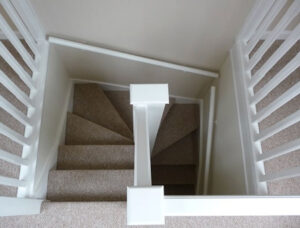 There are many designs when it comes to your staircase, for example, would you like it to start with a Curtail tread or a bullnose, would you like the first two treads starting before a newel is fixed, etc.
Regulations state a minimum height requirement when you step off the last tread is to have 2 meter headroom clearance, in special circumstances, this can be reduced to 1.9 meters at the centre as long as the side (String) of the stairs is no lower than 1.8 meters.
Your new staircase for your loft conversion should have a maximum rise (height) of 220mm and a minimum going (tread depth) of 220mm, stairs should have a maximum pitch of no more than 42°, yet there is no regulation to the width of a staircase. Handrails should be at least to one side of the staircase, both sides if the stairs are over a meter wide, handrails on the stairs or any balustrade should be set at least 900mm height, no openings (between spindles) in the rake or balustrade should allow a gap of no more than 100mm.
MEANS OF ESCAPE FROM A BOWNESS LOFT CONVERSION:
A house that is extended or altered to add a third storey has to comply with stringent emergency escape provisions. The conversion of a roof space that provides one or more new habitable rooms at second floor level should include the following provisions:
There are many designs when it comes to your staircase, for example, would you like it to start with a Curtail tread or a bullnose, would you like the first two treads starting before a newel is fixed, etc.
Regulations state a minimum height requirement when you step off the last tread is to have 2 meter headroom clearance, in special circumstances, this can be reduced to 1.9 meters at the centre as long as the side (String) of the stairs is no lower than 1.8 meters.
Your new staircase for your loft conversion should have a maximum rise (height) of 220mm and a minimum going (tread depth) of 220mm, stairs should have a maximum pitch of no more than 42°, yet there is no regulation to the width of a staircase. Handrails should be at least to one side of the staircase, both sides if the stairs are over a meter wide, handrails on the stairs or any balustrade should be set at least 900mm height, no openings (between spindles) in the rake or balustrade should allow a gap of no more than 100mm.
MEANS OF ESCAPE FROM A BOWNESS LOFT CONVERSION:
A house that is extended or altered to add a third storey has to comply with stringent emergency escape provisions. The conversion of a roof space that provides one or more new habitable rooms at second floor level should include the following provisions:
- The existing stairway/stairwell at the ground and first floor levels should be enclosed and the stairway should open directly to a final exit, or to space which provides two escape routes, each to a final exit, and separated from each other.
- The new stairway must comply with the requirements of the regulations. A new staircase within an existing stairway enclosure should be separated from any new rooms and should be separated from that room and the rest of the house by fire-resisting construction.
- Escape routes over balconies or flat roofs (of fire-resisting construction) will require to be protected by guardrails in accordance with the Regulations.
- The installation of hard wired and battery back up smoke alarms in all habitable rooms off the escape route is mandatory unless you have an open plan staircase a sprinkler system will have to be introduced.
From your initial contact, we will arrange a convenient time to suit you to visit your home and discuss your requirements, each loft conversion is designed to your own individual specification to gain maximum comfortable & versatile living. The main loft conversions are a Velux / Rooflight Conversion, Hip to Gable Conversions and of course the most popular to gain the maximum floor area the Rear Dormer Conversion. All flat roof dormer roofs are covered in a seamless rubber membrane unless a Cat Slide roof is introduced.
Following our visit, we will prepare you a written and fixed price proposal on your loft conversion, if Rafter Loft Conversions are your perfect partners a time & date will be arranged for our architect to visit your home to undertake a structural survey in order to prepare your plans for approval after you have approved the plans we will submit them to building control along with structural calculations to get full approval.
On the mutual convenient date to start work, the bulk of the materials will be delivered on the first morning. Once the steels and primary beams are in place the construction of the floor can commence, whilst at this stage, your floor to floor is determined, then and only then your bespoke staircase will be ordered to match the new floor to floor height. The next stage is to upgrade your roof structure and fit if any Velux roof windows, following the installation of the windows the insulation is then introduced to make the new room conform with the latest regulations.
Now we’re ready to build the new internal walls and divide the loft into rooms you require, once completed the stairwell aperture will be carefully cut out, then your bespoke staircase will then be fitted to access your new loft room/s. After installing the staircase there are a few days to finish the joinery work ready for the plasterers. Our time served plasterers will commence work when all joinery has been completed.
- Class A Part 1 Enlargements, improvements or alterations of dwellings generally.
- Class B Enlargement or conversion of a dwelling that involves addition or alteration to the roof.
Where a new bathroom is located in a loft conversion, provisions are required for the height and for hot and cold water supplies and drainage. Access must be made available for maintenance to any water tanks re-located into the void areas.
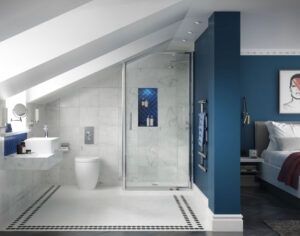
If pipe-runs from the hot water cylinder are long, and the appliances will only have occasional use, for example, a guest bathroom, the use of electric instantaneous water heaters to basins and showers might be considered as an alternative.
If you choose to have a bathroom in your loft conversion the position of the existing drainage will influence the location of sanitary fittings in that there is a maximum permitted length for unvented branch connections from baths and basins. If the lengths of branch pipes exceed these requirements they must be directly ventilated to the external air.
Alternatively, a ventilating pipe may terminate inside the building if fitted with an air admittance valve, an AAV installed internally are usually fitted within rooms or in the roof space, the great advantage of using an AAV is that they remove the need for holes through the roof or external walls, and reduce the amount of pipework required.
STRUCTURAL STABILITY REQUIRED FOR A BOWNESS LOFT CONVERSION:
New structural members or alterations to existing structural members in order to convert an existing roof must be undertaken by a structural engineer, this is to ensure both the stability of the existing structure and the structural sufficiency of the new structure, formal calculations may be requested by Building Control in support of an application for approval.
SOUND INSULATION REQUIRED FOR A LOFT CONVERSION:
All walls separating dwellings must have adequate airborne sound insulation. Existing separating walls in roof spaces may not provide adequate resistance to airborne sound if the roof is converted into occupied space on one side of the separating wall. If an attic room abuts a separating wall, the wall must, therefore, be lined to provide equivalent sound insulation to the separating wall elsewhere in the building.
Gaps left in existing separating /party walls should be filled with bricks or blocks with a sand and cement mix. If a timber frame is used it should only be fixed to the floor and roof structure, any gaps between the framing and the floors and roofs sealed with acoustic sealant. Separate timber frames will reduce the roof space dimension between separating walls by approximately 90mm.
Plasterboard lining to a timber-framed separating wall will normally be adequate for fire resistance but additional plasterboard may be required to improve sound insulation. Mineral fibre/plasterboard laminates can be used to line timber frame and masonry separating walls to improve both sound insulation and fire resistance.
In residential dwelling houses, if a loft conversion is going to be constructed, construction should be designed in such a way that it provides reasonable resistance to sound from other parts of the same building and from adjoining neighbours.
VENTILATION OF NEW LOFT CONVERSION:
Windows to habitable rooms should be proportional to the floor area with background ventilation as required in all rooms. Bathrooms should be provided with an opening window, and a mechanical ventilation fan should also be provided which may be operated intermittently.
The introduction of a room into a previously open roof space will restrict the flow of natural ventilation through the roof intended to avoid condensation. The existing ventilation provision, if any, at the eaves may have to be increased to maintain a continuous airflow, a 50mm gap should be maintained on a flat roof dormer to provide a lateral flow of air.
Where accommodation occurs within a roof space. It is important to incorporate a vapour control layer on the warm side of the insulation for both walls and sloping ceilings.
Adequate room ventilation is required to prevent the build of water vapour within the rooms. Extract ventilation to bathrooms and kitchens and background ventilation to habitable rooms should provide sufficient ventilation for this purpose.
Any habitable accommodation inserted into the roof space will be above this insulation and has to be insulated in line with the requirements of the current National Regulations. This can be done by either insulating the whole roof pitch from the ridge to eaves or by insulation around the new accommodation only.
The first method is more complicated to do and will involve more insulation material, particularly in the apex of the roof.
The second method saves on the amount of insulation required, the walls and any part of the sloping ceiling and any horizontal ceiling over the habitable space will, in this case, need to be insulated.
Any gable wall in the roof accommodation will have to be insulated to conform with thermal requirements for external walls. This can be done by using plasterboard with insulation laminated to the back face or in timber-frame construction by inserting mineral wool insulation between the studs before lining them with a vapour control layer and plasterboard.
FIRE RESISTANCE IN A LOFT CONVERSION:
All loft conversions must conform with fire requirements in the National Regulations. This largely concerns the conversion of an upper floor ceiling to new floor construction, which must then achieve the fire resistance of an intermediate floor – normally 30 minutes.
The requirement for fire resistance includes any member supporting a floor, even if this extends beyond the actual floor area of the accommodation, I.e. between the outer wall of a loft space and the external wall at the eaves. (Note, if the roof accommodation will be of a different occupancy, such as a separate flat, to that on the floor below, it may be necessary to achieve full separating floor fire resistance, usually 60 minutes.)
If an existing floor supports a new staircase to habitable space in the roof, If an attic wall forms part of a separating wall, between properties, it must achieve the full fire resistance of a separating wall.
If the roof space incorporates a chimney or a flue any new construction must comply with the space separation requirements for combustible material. No combustible material other than a floor, skirting, picture rail, mantle-shelf or architrave should be closer than 200mm to a flue in a chimney or 40mm from the outer surface of a masonry chimney. Nails, screws or other metal fixing timber to a masonry chimney should be at least 50mm from the flue always remember to consider the position of the chimneys and ventilation stacks in relation to the position of windows.
SURFACE SPREAD OF FLAME:
Walls and ceilings to any new accommodation within the roof must comply with the appropriate spread of flame requirements. The plasterboard will meet the spread of flame requirements. Any surface that slopes at an angle of 70 degrees or more to the horizontal is deemed to be a wall.
There probably is no doubt Velux® windows are the world’s leading roof window manufacturer, there are two main types of roof windows, and numerous sizes to choose from, top hung & centre pivot windows come in three internal finishes, white painted, pine and polyurethane, polyurethane windows are ideal in humid rooms like bathrooms.
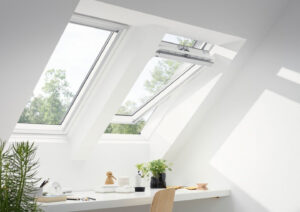
The top hung window is operated with a handle at the bottom of the frame for it to fully open outwards which are a perfect choice for loft conversions, this particular window is suitable for roof pitched between 15° and 55°.
The centre pivot roof window has a handle (bar) at the top of the window making them practical to have furniture underneath as the window swivels at the centre point, this particular window is suitable for roof pitches between 15° and 90°.
The Velux Integra® window is for pure comfort, Integra windows are remotely controlled so every window can be opened at the touch of a button, again these windows are suitable for pitches between 15° and 90°.
Velux Cabrio® balcony windows are the largest of windows and open in seconds, the innovative balcony design can add stunning views for any loft conversion, the suitable pitch is between 35° and 53°.
Each Velux® window has its own code, for example, a GGU SK06 (114cm x 118cm) is a centre pivot window in polyurethane, whilst the GPL SK06 is a top hung window in Pine, the same is with the window flashing kits which are required for each window, an EDW SK06 flashing is for tiles with a profile not exceeding 120mm, and an EDP flashing is for tiles with a maximum profile of 15mm, therefore it is imperative to choose the correct window and flashing kit for your home.
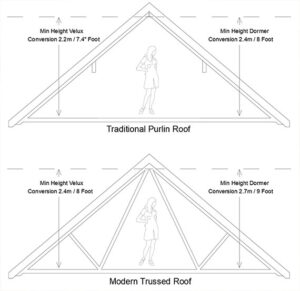 From the 1960’s modern Trusses were introduced, even though there are a few different trusses on sale the most common for a standard home is the 7 Node fink truss, this particular truss comprises of tension webbing and compression webbing, the webbing timbers should not be removed under any circumstances until your roof has been upgraded with new supports in place (i.e. steel mainly) then the tension/compression webbing can be carefully removed as your loft conversion progresses. Truss loft conversions can be more demanding due to the framework being in place but still can be converted. The minimum height required for a truss rafter roof loft conversion in BOWNESS is 2.4m, again the measurement should be from the ceiling joist to the underside of the truss, (gang plate)
GUIDELINES FOR A SAFE LOFT CONVERSION IN BOWNESS:
Working and undertaking a loft conversion can be tricky therefore it’s important when building the loft conversion that you follow loft safety, as you need to make sure that you not only keep yourself safe but whoever is involved in the particular loft conversion build by following appropriate loft regulations and building regulations.
The first thing is to make sure you have secure footing, this would probably mean placing floorboard sheets until you completed the necessary works in that particular area. Once you have the new floor down in your loft conversion then you would fit your bespoke staircase, again this can be fairly hazardous as you have to juggle the stair sections into place before getting a secure fixing, sounds easy, but you have to have the risers vertical and your treads horizontal and to make sure your integral newels are plumb.
From the 1960’s modern Trusses were introduced, even though there are a few different trusses on sale the most common for a standard home is the 7 Node fink truss, this particular truss comprises of tension webbing and compression webbing, the webbing timbers should not be removed under any circumstances until your roof has been upgraded with new supports in place (i.e. steel mainly) then the tension/compression webbing can be carefully removed as your loft conversion progresses. Truss loft conversions can be more demanding due to the framework being in place but still can be converted. The minimum height required for a truss rafter roof loft conversion in BOWNESS is 2.4m, again the measurement should be from the ceiling joist to the underside of the truss, (gang plate)
GUIDELINES FOR A SAFE LOFT CONVERSION IN BOWNESS:
Working and undertaking a loft conversion can be tricky therefore it’s important when building the loft conversion that you follow loft safety, as you need to make sure that you not only keep yourself safe but whoever is involved in the particular loft conversion build by following appropriate loft regulations and building regulations.
The first thing is to make sure you have secure footing, this would probably mean placing floorboard sheets until you completed the necessary works in that particular area. Once you have the new floor down in your loft conversion then you would fit your bespoke staircase, again this can be fairly hazardous as you have to juggle the stair sections into place before getting a secure fixing, sounds easy, but you have to have the risers vertical and your treads horizontal and to make sure your integral newels are plumb.
Your dusty loft may not look like much at the moment but all it takes is a bit of imagination and creativity you are able to turn it into anything you desire, a loft bedroom is, of course, is one of the most common uses for a loft conversion. People have the image of lying in bed and looking up through their window at the stars or having their own private bedroom away from the noise of the rest of the house.
Adding a bathroom into the equation may make things slightly more complicated the main concern in a loft bathroom is the toilet installation, toilets need to be located near a soil pipe to get the adequate fall for the waste, if the soil pipe is too far away then a macerator can be installed which is used to move the waste to the main soil stack.
Using your loft to create a playroom will not only be popular with the children but will also give you some peace and quiet. You can soundproof your loft by fitting the walls with soundproof boarding. You can also get acoustic loft installation which will be able to keep the sound. Converting your loft into a playroom is a good idea for both young and old children, it can be a good storage place for children’s toys and give older children a bit of independence.
Having the benefit of an extra room in your house means you can afford to create it into anything you wish. It may be that your hobby is collecting trains or for painting, you can create your very own hobby room and have the comfort of knowing you are not disturbing anyone else in the home. Creating a home office in the loft is also a popular conversion choice, the list is endless.
Having bats in your roof space does not necessarily mean that work cannot be carried out however it does mean that the work will need careful consideration, especially in terms of time and materials. All of the UK’s bats and their roosts are protected by law so if you are planning any building or remedial work that may affect a roost, The Bat Conservation Trust’s should be contacted for advice and will provide advice on how to proceed while causing minimal disturbance to bats.
There are more than 1,300 bat species in the world, and bats can be as large as a small dog or as small as a bee. The largest bats have wingspans of up to 2 metres and bodyweight of up to 1.5 kilograms. At the other end of the scale is the bumblebee bat, weighing only 2 grams. We only have only 18 species of the 1,300 bat species in the UK. It is an illegal offence if you: Capture, injure or kill a bat, intentionally destroy their home or disturb them, intentionally obstruct access to a bats roost or exchange or sell a bat, whether dead or alive.
ROOF BEAMS IN A LOFT CONVERSION:
When purlins and supports are to be removed to form usable space, alternative support must be provided to the rafters. It is important to establish the total function of the existing purlin since in some cases purlins and ties may provide resistance to outward thrust as well as vertical support.
A number of alternative solutions are possible depending upon the size and construction of the roof, such as the following (either individually or in combination)
- If existing purlin support has to be removed alternative support off existing load-bearing walls below or onto a new supporting structure in the roof space is required.
- Insert new purlins at new levels, this may necessitate additional rafter support because of the longer rafter span between the new purlin and the eaves. This can be provided by an additional purlin or by stiffening the rafters with new timber alongside the existing.
- Insert a ridge beam, the simplest way of installing a ridge beam is to go from gable/party to gable/party walls. Inserting a ridge beam should be considered when it is necessary to remove existing ceiling joists. Adding a ridge beam minimizes outward thrust in the rafters.
- It is uneconomic to use solid timber purlins for unsupported spans in excess of 4.0m. Internal load-bearing walls or posts should be used where the span exceeds 4.0m. For longer spans, or where no intermediate support is possible, fabricated timber or steel beams should be considered
- Deep beams may be used to support both roof and floor load, using either metal hangers nailed to the primary beams to carry the floor joists.
Alternative timber beams include:
- Plywood web I-beam
- Plywood box-beam
- Steel flitch beam
- Glulam beam (Glued Laminated Timber)
MEANS OF ESCAPE:
A house that is extended or altered to add a third storey has to comply with stringent emergency escape provisions. The conversion of a roof space that provides one or more new habitable rooms at second-floor level should include the following provisions:
- The existing stairway/stairwell at the ground and first floor levels should be enclosed and the stairway should open directly to a final exit, or to space which provides two escape routes, each to a final exit, and separated from each other.
- The new stairway must comply with the requirements of the regulations. A new staircase within an existing stairway enclosure should be separated from any new rooms and should be separated from that room and the rest of the house by fire-resisting construction.
- Escape routes over balconies or flat roofs (of fire-resisting construction) will require to be protected by guardrails in accordance with the Regulations.
- The installation of hard-wired and battery back up smoke alarms in all habitable rooms off the escape route is mandatory unless you have an open plan staircase a sprinkler system may be introduced.
LOFT CONVERSION PROCESS IN BOWNESS:
- If Scaffolding is required for your loft conversion this will be put up a couple of days prior to works commencing.
- The main primary beams are the which take the new floor and roof load are put in place, if steels are required these will be either craned into position or spliced into manageable sections and winched onto the scaffolding, ready to put in place.
- The floor joists are put in place as per structural calculations, i.e. 300mm centres to 450mm centres.
- Once the floor is decked the rear roof can be stripped and a rear dormer or a wrap-around can be constructed, if applicable. All dormers are built within a day and securely sealed.
- The roof structure will be upgraded for the installation of roof windows.
- The carcass of the loft is insulated and plaster-boarded, any wiring or pipework will be put in place prior to plaster-boarding.
- Partition walls are then introduced where required.
- The stairwell will be cut out now for the installation of your bespoke staircase, and all second fix joinery completed, door frames, doors, skirting, architrave, handrail, spindles, etc.
Second fix electrics, plumbing, and plastering will be all completed in the final week of works.
Loft conversions usually have low heat losses due to the high elemental insulation requirements required, as long as the existing boiler has sufficient capacity there should be no problem adding additional radiator/s. If the conversion forms part of a larger refurbishment, then a new central heating system may be viable. An electrical radiator can be introduced in your new loft room if the pipework is inaccessible.
Any re-roofing necessary in converting the roof must conform with the performance of the original roof in terms of fire resistance, durability and general fitness for purpose. Preservative treatment to roof timbers is not mandatory, but if evidence of the previous infestation of woodworm or previous fungal decay is visible treatment should be undertaken prior to sealing the roof structure.
Yes. We will require coming to your home at a time that is convenient, take a look at your loft space, and take some measurements to consider all your options, and to go through the stair configuration, also this gives you also the opportunity to ask any questions you may have. Once we have the information we require we can then provide you with a bespoke detailed quotation and free cad drawing of your new loft conversion.
Loft conversion quotes are valid for 21 days from the date of issue, this is due to ever-changing prices on the materials. The price we quote is a fixed price and will not change, however, if you would like to amend the speciation then we will provide you with a cost prior to any works starting if you require any additions during construction we will agree a fixed price before any additional work is undertaken.
WHAT WE OFFER:
A free initial consultation with free Cad drawing of your loft.
Fully detailed project specification and quotation.
Design concept.
Fully experienced surveying & structural engineer.
Liaising with the planning office & planning control, to obtain the desired outcome on your behalf. (If applicable)
Project scheduling, coordination, and management on and off-site.
Liaising with building control until the final certificate is issued for all building services.
Rafter Loft Conversions aim is to provide all our clients with a loft conversion package in BOWNESS that represents excellent value for money. As a client of Rafter Loft Conversions you will benefit from the following services.
Once a free, no-obligation site survey has been undertaken in your home, you will receive a quotation that will have a clear breakdown of costs associated with your loft conversion. If you decide to choose Rafter Loft Conversions as your contractor, the price will remain fixed.
Rafter Loft Conversions provide a comprehensive all in one loft conversion package service and oversee every step of the process from the design of your loft conversion, through planning approval if required, through to the end of the construction. It starts with a free no-obligation quotation with an accurate timescale for the project. If you’re happy to proceed, Rafter – Lofts will draw up professional plans, to cater to your exact specifications.
As a client of Rafter Loft Conversions, you will benefit from the attention of a Project Manager, who’s on hand to ensure that the project is built & completed on time, and you’re free to ask any questions that you may have.
Considering a loft conversion in BOWNESS call our friendly team today on Freephone 0800 161 3815 for your free bespoke loft conversion quote & Cad drawing. Or fill in our Contact form.
For advice on any type of loft conversion or to book a free no-obligation loft conversion
- Fill Form Below
-
-
HELP DESK 24H/7
Related searches for a loft conversion company include: loft conversion specialists, loft refurbishments, loft renovation, loft remodeling, loft storage, roof lift loft conversions, loft conversion on detached houses, flat roof dormer conversions, cheap loft conversions, loft makeover, hip-to-gable loft conversion, terraced house loft conversion, part build loft conversions, loft transformation, free loft conversion survey, Velux loft conversions, loft conversion idea, roof light conversions, loft boarding, loft conversion windows, loft conversion on a semi-detached house, loft conversion stairs, loft conversion ideas, loft conversion cost, Velux windows, bungalow loft conversion, how to start a loft conversion, loft conversion plans, loft conversion designs, loft conversion price, loft conversion regulations, small loft conversion, loft conversion floor joist regulations, loft conversion before and after, loft conversion specialists.
Related searches also include: loft conversions Manchester, loft conversions Abbey Hey, loft conversions Alderley Edge, loft conversions Altrincham, loft conversions Abram, loft conversions Ancoats, loft conversions Audenshaw, loft conversions Ashton Under Lyne, loft conversions Ardwick, loft conversions Astley, loft conversions Atherton, loft conversions Blackrod, loft conversions Blackley, loft conversions Bredbury, loft conversions Broadbottom, loft conversions Bolton, loft conversions Bryn, loft conversions Burnage, loft conversions Bramhall, loft conversions Bury, loft conversions Broadbottom, loft conversions Cadishead, loft conversions Cheadle, loft conversions Cheshire, loft conversions Cheetham Hill, loft conversions Chadderton, loft conversions Chorlton, loft conversions Denton, loft conversions Duckinfield, loft conversions Droylsden, loft conversions Dunham Massey, loft conversions Didsbury, loft conversions Eccles, loft conversions Failsworth, loft conversions Fallowfield, loft conversions Farnworth, loft conversions Gatley, loft conversions Gorton, loft conversions Hale, loft conversions Harwood, loft conversions Hattersley, loft conversions Heaton Moor, loft conversions Hazel Grove, loft conversions Heywood, loft conversions Hindley, loft conversions Hollingworth, loft conversions Horwich, loft conversions Hulme, loft conversions Hyde, loft conversions Ince In Makerfield, loft conversions Irlam, loft conversions Kearsley, loft conversions Knutsford, loft conversions Lees, loft conversions Leigh, loft conversions Levenshulme, loft conversions Little Lever, loft conversions Littleborough, loft conversions Longsight, loft conversions Marple, loft conversions Mellor, loft conversions Middlebrook, loft conversions Middleton, loft conversions Milnrow, loft conversions Mossley, loft conversions Mossley, loft conversions Mottram, loft conversions Moston, loft conversions Newhey, loft conversions Newton Heath, loft conversions Northenden, loft conversions Offerton, loft conversions Oldham, loft conversions Ordsall, loft conversions Pendlebury, loft conversions Prestwich, loft conversions Radcliffe, loft conversions Ramsbottom, loft conversions Reddish, loft conversions Rochdale, loft conversions Romiley, loft conversions Royton, loft conversions Rusholme, loft conversions Saddleworth, loft conversions Sale, loft conversions Salford, loft conversions Stalybridge, loft conversions Standish, loft conversions Stockport, loft conversions Swinton, loft conversions Tameside, loft conversions Timperley, loft conversions Tottington, loft conversions Trafford, loft conversions Tyldesley, loft conversions Urmston, loft conversions Walkden, loft conversions Wardle, loft conversions Westhoughton, loft conversions Whalley Range, loft conversions Whitefield, loft conversions Wilmslow, loft conversions Winstanley, loft conversions Withington, loft conversions Worsley, loft conversions Wythenshawe, loft conversions Ashton In Makerfield, loft conversions Penwortham, loft conversions Abbeystead, loft conversions Accrington, loft conversions Aldcliffe, loft conversions Ambleside, loft conversions Anderton, loft conversions Appley Bridge, loft conversions Bacup, loft conversions Barnoldswick, loft conversions Bamber Bridge, loft conversions Beswick, loft conversions Blackburn, loft conversions Bilsborrow, loft conversions Blackpool, loft conversions Bowness, loft conversions Bradshaw, loft conversions Brinnington Poynton, loft conversions Burnley, loft conversions Calder Vale, loft conversions Catforth, loft conversions Chorley, loft conversions Clitheroe, l oft conversions Cockermouth, loft conversions Coniston, loft conversions Cumbria, loft conversions Edgeworth, loft conversions Elswick, loft conversions Fleetwood, loft conversions Fulwood, loft conversions Galgate, loft conversions Garstang, loft conversions Golborne, loft conversions Inskip, loft conversions Kendal, loft conversions Kirkham, loft conversions Lancashire, loft conversions Lancaster, loft conversions Leyland, loft conversions Lymm, loft conversions Longridge, loft conversions Lytham, loft conversions Macclesfield, loft conversions Morecambe, loft conversions Morley Green, loft conversions Northwich, loft conversions Orrell, loft conversions Pilling, loft conversions Poulton, loft conversions Prestbury, loft conversions Preston, loft conversions Ribchester, loft conversions Rawtenstall, loft conversions Rufford, loft conversions Rossendale, loft conversions Samlesbury, loft conversions Shevington, loft conversions Skipton, loft conversions South Turton, loft conversions Southport, loft conversions St Helens, loft conversions Cleveleys, loft conversions Ulverston, loft conversions Warrington, loft conversions Warton, loft conversions Weeton, loft conversions Widnes, loft conversions Workington, loft conversions Wigan, loft conversions Windermere, loft conversions Wrea Green, loft conversions Burscough, loft conversions Grimsargh, loft conversions Buckshaw Village, loft conversions Tarlton.
Copyright © 2023 Free Cad Loft Design – Rafter Loft Conversions – Manchester & Lancashire – Designed by Websarc
